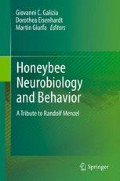Abstract
Several strategies (touch, vision, hearing, substrate vibrations, and air flows) have been proposed for how follower bees obtain information about the distance and direction announced in waggle dances. This review deals with the sounds and air flows generated by dancing bees. The vibrating wings of the dancer act as dipoles, and the surprisingly large sound pressures and air flows decrease rapidly with distance, thus restricting the possible range of communication. The movements and air flows have been mimicked in a robot dancer, which was able to direct follower bees to positions in the field, but caused less recruitment than live dancers. Subsequent measurements with a laser technique showed that the oscillating air flows caused by the wing vibration and wagging movements are probably too complicated to transmit the information about the direction to the target. However, the laser studies showed that the vibrating wings could cause a jet air flow behind the dancer’s abdomen. The jet is generated by the vibrating wings, and it is so narrow in a plane parallel to the comb that it may provide information about direction to follower bees located behind the dancer. Measurements with hot wire anemometers confirmed the existence of the narrow jet behind live dancers. In addition, it was found that the narrow jets may exist together with a broad flow of air, which seems ideally suited for transporting dance pheromones. Both the narrow and broad flows can be switched on and off by the dancer, apparently by adjustments of the positions of the wings.
Access this chapter
Tax calculation will be finalised at checkout
Purchases are for personal use only
Abbreviations
- Pa:
-
Pascal = 94 dB SPL
- PIV:
-
Particle image velocimetry
References
Esch H (1961) über die Schallerzeugung beim Werbetanz der Honigbiene. Z vergl Physiol 45(1):1–11
Esch HE (1963) Über die Auswirkung der Futterplatzqualität auf die Schallerzeugung im Werbetanz der Honigbiene. Verh Dtsch Zool Ges:302–309
Horridge A (2009) What does the honeybee see? And how do we know?: A critique of scientific reason, ANU E Press, Canberra
Judd TM (1995) The waggle dance of the honey bee – which bees following a dancer successfully acquire the information. J Insect Behav 8(3):343–354
Kilpinen O, Storm J (1997) Biophysics of the subgenual organ of the honeybee, Apis mellifera. J Comp Physiol A 181(4):309–318
Kirchner WH, Dreller C, Towne WF (1991) Hearing in honeybees – operant-conditioning and spontaneous reactions to airborne sound. J Comp Physiol A 168(1):85–89
Michelsen A (2003) Signals and flexibility in the dance communication of honeybees. J Comp Physiol A 189(3):165–174
Michelsen A, Andersen BB, Storm J, Kirchner WH, Lindauer M (1992) How honeybees perceive communication dances, studied by means of a mechanical model. Behav Ecol Sociobiol 30(3–4):143–150
Michelsen A, Towne WF, Kirchner WH, Kryger P (1987) The acoustic near field of a dancing honeybee. J Comp Physiol A 161:633–643
Rohrseitz K, Tautz J (1999) Honey bee dance communication: waggle run direction coded in antennal contacts? J Comp Physiol A 184(4):463–470
Tautz J (1996) Honeybee waggle dance: recruitment success depends on the dance floor. J Exp Biol 199(6):1375–1381
Thom C, Gilley DC, Hooper J, Esch HE (2007) The scent of the waggle dance. PLoS Biol 5(9):1862–1867
von Frisch K (1967) The dance language and orientation of bees. Belknap Press of Harvard University Press, Cambridge
Wenner AM (1962) Sound production during the waggle dance of the honeybee. Anim Behav 10:134–164
Author information
Authors and Affiliations
Corresponding author
Editor information
Editors and Affiliations
Rights and permissions
Copyright information
© 2012 Springer Science+Business Media B.V.
About this chapter
Cite this chapter
Michelsen, A. (2012). How Do Honey Bees Obtain Information About Direction by Following Dances?. In: Galizia, C., Eisenhardt, D., Giurfa, M. (eds) Honeybee Neurobiology and Behavior. Springer, Dordrecht. https://doi.org/10.1007/978-94-007-2099-2_6
Download citation
DOI: https://doi.org/10.1007/978-94-007-2099-2_6
Published:
Publisher Name: Springer, Dordrecht
Print ISBN: 978-94-007-2098-5
Online ISBN: 978-94-007-2099-2
eBook Packages: Biomedical and Life SciencesBiomedical and Life Sciences (R0)

